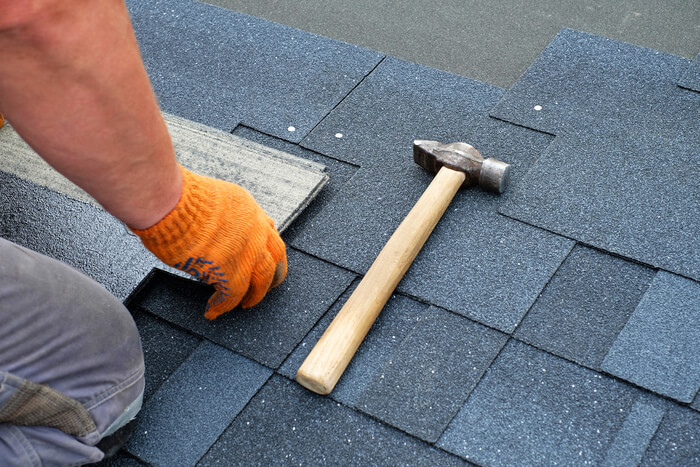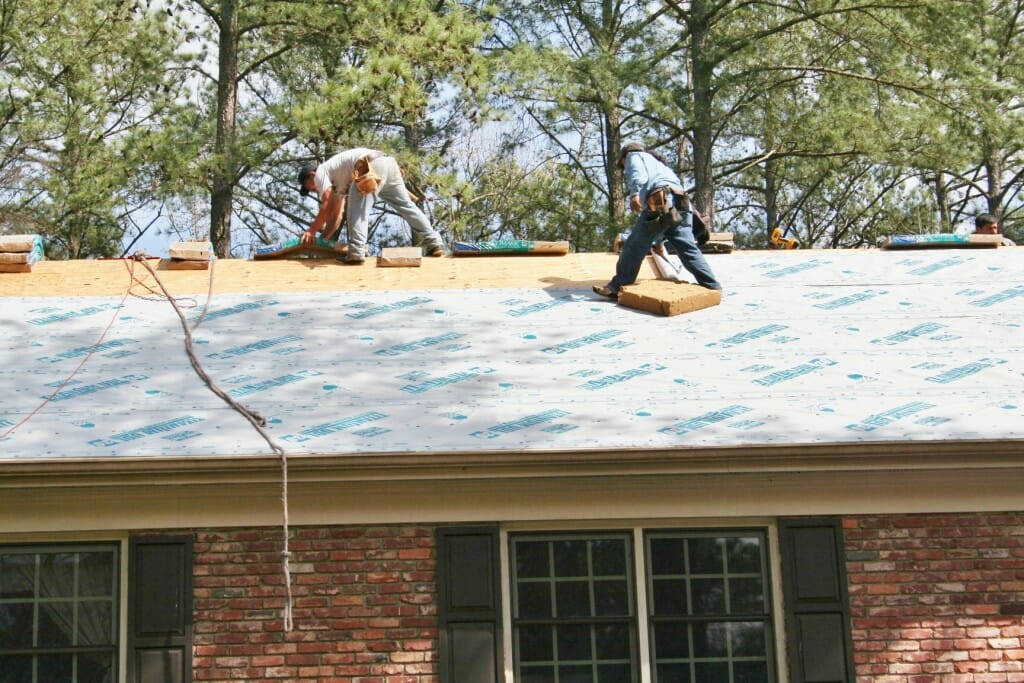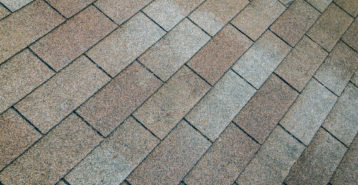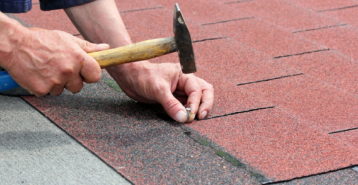How to Install Roofing Shingles
Learning how to install roofing shingles can help you save money on your roofing project. Shingle roofing is one of the simpler types of roofing to install on a home and it is the kind that most homeowners can work up the courage to actually attempt. This professional guide will teach you exactly how to install roof shingles yourself. If you are considering installing new asphalt shingles on your roof, learn the steps involved with a quality roof installation and then decide whether or not you really want to tackle the project yourself or if you would like to get quotes from local roofing installation contractors. In this guide you will learn things like:
- Calculating How Many Shingles You Need
- How to Install Roof Flashing
- How to Install Roof Underlayment
- Steps for Installing the Roof Shingles
It is always smart to get roofing price quotes from three to four licensed asphalt roof professionals before starting your project. Even if you plan to install roof shingles DIY, connecting with a professional will give you an idea of the cost to install a new roof, so you can determine if hiring a pro is worth the price.
Steps for Installing Roof Shingles
In this section, we will walk you through how to install shingle roofing step-by-step. Note that this project is best only for highly skilled DIYers or trained roofing professionals. If any of these steps are too complicated for your skill set, it is best that you contact a roofing professional to complete the job.
Step 1: Calculate How Many Shingles You Need
Before you learn how to install roof shingles and actually begin the installation process, you have to know how many you need. If you don’t already have measurements that you can use—such as paperwork from prior roofing work—you need to measure your roof:
- Use a tape measurer to find the length and width of each section of your roof.
- Multiply each section of your Roof’s Length x Roof’s Width = Roof’s Surface Area (of that section).
- Repeat for each section of your roof.
- Add all of the Roof Surface Area sections together = Roof’s Surface Space (ft.)
- Divide Roof’s Surface Space by 100 = Square feet (also known as “squares”). For example: a 10 Square Roof is actually 1000 sq. ft overall.
- Use this number to buy the correct amount of asphalt roofing shingles and underlayment to cover your total roof area + 10%.
The simplest way to get the area of your roof is to climb up with your tape measure, getting help from a friend or family member. This may be a job best left to a professional roofer if you have any safety concerns about being on a roof.
Measure the length and the width of each section of your roof and multiply the two dimensions together. This gives you the roof’s surface area of that individual section of roofing. Add all the roof’s areas together to find out exactly how much roof surface space there is overall. Do this in feet and then divide the total that you come up with by 100 to get your figure from square feet to what is known as squares. For instance, a 10 square roof is actually 1,000 square feet overall.
Once you know how much square footage you have to cover, you can buy your shingles and your underlayment. Be sure to buy enough to cover your total roof area plus 10%. This ensures that you will have enough roofing to completely get the job done.
Step 2: Install the Flashing on Your Roof
The second step for installing roof shingles is to get any roof flashing in place that is not already there. Every one of the valleys in your roof, or the sections where one part of your roof runs into another part at a different angle, needs to have flashing added in.
Roll out flashing in each of these sections and lock it down using roofing nails at the outside edges, while leaving the center free of any nails. Nailing too close to the center of this flashing will result in leaks through your roof. As you are installing the shingles around valley flashing you have to remember to apply roofing cement underneath each row of shingles up close to the valley.
Also add flashing where the roof hits a wall of the house in the case of dormers or a multi-tiered roof. Add flashing around any chimneys or skylight windows to protect them against the elements.
Step 3: Installing Roof Underlayment
After you finish installing the flashing, prepare the surface of your roof for the shingles. To do this, you need to install a drip edge, an ice and water barrier, and an underlayment.
- First, adhere the ice and water underlayment along the edge of your roofline with staples or nails. Make sure that it folds down and over the face edge of the roof by an inch or two.
- With the ice and water barrier in place along the lower edge of the roofline, nail the upper face of the drip edge down on top of the ice barrier. Make sure to overlap the drip edge at the seams to get a continuous protective surface.
- With the drip edge and ice and water barrier in place at the bottom, move on to installing the underlayment you chose. Roll out a single roll of the material so that it hangs down over your drip edge.
- Lock it down using cap nails spaced out about every 8 inches throughout the roof. Bring the cap nails to around 4 inches apart at the lower edge of the underlayment. Be careful not to nail down into the drip edge on the first run.
- On subsequent runs of the underlayment, continue installing one row after another so that the next row overlaps the previous by at least 6 inches. Do this until you completely cover the roof up to just below the ridge on each side.
- Now, put a run of felt paper over top of the ridge, so that it splits right in the middle of the ridge and comes down to cover and overlap the underlayment on either side.
- Finish by adding drip edge along the sides of the roofline over top of your underlayment.
Now you are ready to begin installing the shingles!
Step 4: Installing the Roof Shingles
You took the time to properly protect your roof against ice and water that tries to drip back underneath your shingles as it is flowing down. Now it is time to install the roof shingles!
Begin your shingle installation by laying a row of starter shingles along the lower edge of the roofline. Nail them down using roofing nails. With the starter shingles laid along the very edge of the roof, run a set of starter shingles along the sides of the roof as well. Make sure that those rows come down and overlap the starter shingles you laid at the bottom.
Lay your first row of shingles so it overhangs the drip edge by about one inch. Put between four and six nails into each shingle below the tar line, but above where the bottom of the next shingle will cross by about ½”.
Do this on both sides of your roof. Then, install ridge cap shingles over top of the ridge. Start at the left side of the ridge and nail the first shingle on the right side. Lay the next cap shingle over the first so it covers that nail, and nail it in the same way on the left side. Continue this all the way to the end of the roof. Seal the nail holding the final cap shingle with a bit of roofing tar to help prevent water from getting in.
Protecting the Pipes and Vents
Make sure that you have rubber protective boots secured by flashing around all of the vents and pipes as you are installing your shingles. These protective boots need to be snug to the pipe or vent with the lower flashing on top of the shingles and the upper flashing below the shingles.
On the sides, the flashing should run underneath the shingles and be nailed under the shingles. This allows water to flow down the shingles and run right over the flashing and keep on going without making it into your home. Following these steps accurately will ensure you have properly learned how to install roof shingles.
Double Check Your Work
After you complete the installation, keep a close eye on your home over the next few months. Look for signs of roof leakage in the roof, and look for any sections of the roof that seem to be flapping or blowing up more than they should be. A single mistake can leave a section of shingles ripping off and allow water right into your home. As long as you keep a close eye on your house, you should be able to spot possible mistakes and problems before they become major issues on your home.
When to Hire a Roofing Professional
Installing shingle roofing is a project that a homeowner can complete DIY, but it is not an easy project. It is something that you have to take the time to understand and evaluate your skillset before starting.
If you are not confident in your roofing abilities, it is highly advisable to leave the task up to a professional, instead of attempting the project and making a mistake.
Regardless of the route you decide to take in installing roof shingles, we recommend getting quotes from local roofing contractors to see if it is worthwhile to hire a pro.
Compare top-rated roofing pros in your area.
Read real homeowner reviews, explore qualifications, and view promotions. Modernize makes it easy to browse professionals and find one that will be perfect for your project.













